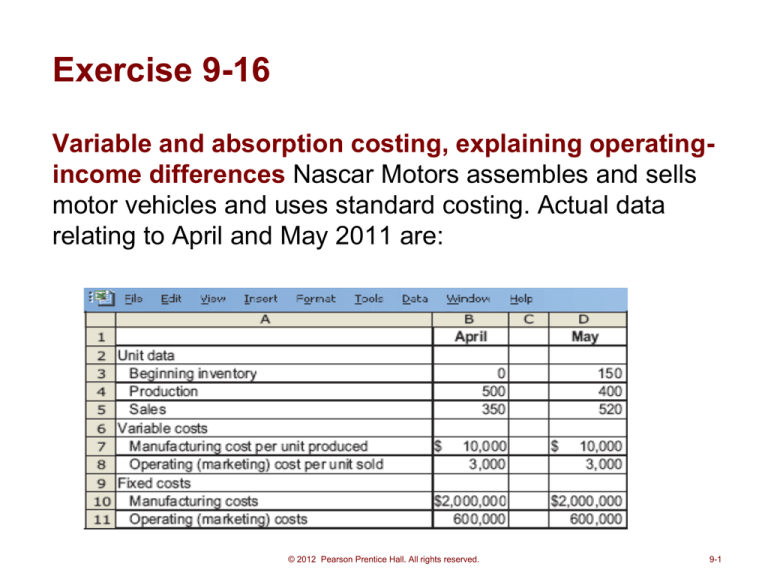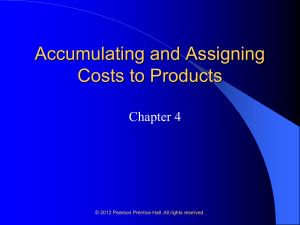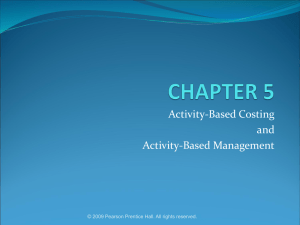
Exercise 9-16
Variable and absorption costing, explaining operatingincome differences Nascar Motors assembles and sells
motor vehicles and uses standard costing. Actual data
relating to April and May 2011 are:
© 2012 Pearson Prentice Hall. All rights reserved.
9-1
The following information is available:
The selling price per vehicle is $24,000. The
budgeted level of production used to calculate the
budgeted fixed manufacturing cost per unit is 500
units. There are no price, efficiency, or spending
variances. Any production-volume variance is
written off to cost of goods sold in the month in
which it occurs.
© 2012 Pearson Prentice Hall. All rights reserved.
9-2
1. Prepare April and May 2011 income
statements for Nascar Motors under:
(a) variable costing
(b) absorption costing
© 2012 Pearson Prentice Hall. All rights reserved.
9-3
(a) variable costing
© 2012 Pearson Prentice Hall. All rights reserved.
9-4
(b) absorption costing
© 2012 Pearson Prentice Hall. All rights reserved.
9-5
2. Prepare a numerical reconciliation and
explanation of the difference between operating
income for each month under variable costing and
absorption costing.
The difference between absorption and variable costing is due solely to
moving fixed manufacturing costs into inventories as inventories increase (as
in April) and out of inventories as they decrease (as in May).
© 2012 Pearson Prentice Hall. All rights reserved.
9-6
Pr. 9-17 Continued from 9-16
1.
April 2011
Revenuesa
$8,400,000
Direct material cost of goods sold
Beginning inventory
Direct materials in goods
manufacturedb
$
Cost of goods available for sale
Deduct ending inventoryc
Other operating costs
$1,005,000
2,680,000
3,350,000
(1,005,000)
3,685,000
(201,000)
2,345,000
6,055,000
3,650,000d
$24,000 × 350; $24,000 × 520
b
$6,700 × 500; $6,700 × 400
c
$6,700 × 150; $6,700 × 30
d
($3,300 × 500) + $2,000,000
3,484,000
8,996,000
3,320,000e
1,650,000f
2,160,000g
Total other costs
Operating income
a
$12,480,000
0
3,350,000
Total direct material cost of goods sold
Throughput margin
Other costs
Manufacturing costs
May 2011
5,300,000
$ 755,000
5,480,000
$ 3,516,000
e
($3,300 × 400) + $2,000,000
($3,000 × 350) + $600,000
g
($3,000 × 520) + $600,000
f
© 2012 Pearson Prentice Hall. All rights reserved.
9-7
Pr. 9-17 Concluded
April
Variable costing
Absorption costing
Throughput costing
$1,250,000
1,850,000
755,000
May
$3,120,000
2,640,000
3,516,000
2. In April, throughput costing has the lower operating income,
and in May throughput costing has the higher income. Throughput
costing puts greater emphasis on sales as the source of operating
income than does either absorption or variable costing.
3. Throughput costing penalizes production without a
corresponding sale in the same period. Costs other than direct
materials that are variable with respect to production are
expensed in the period incurred, but under variable costing they
would be capitalized. So, TP costing removes the incentive to
build up inventory.
© 2012 Pearson Prentice Hall. All rights reserved.
9-8
Denominator Level Concepts
9-25
(10 min.)
Capacity management, denominator-level capacity conce
1. a, b
2. a
3. d
4. c, d
5. c
6. d
7. a
8. b (or a)
9. b
10. c, d
11. a, b
© 2012 Pearson Prentice Hall. All rights reserved.
9-9
9-26--Denominator Level Issues
Budgeted
Fixed
Manufacturing
Overhead Cost
Rate
$ 1,200.00
Denominator
Level Capacity
Concept
Theoretical
Budgeted Fixed
Manufacturing
Overhead per
Period
$ 6,480,000
Practical
$6,480,000
3,840
$1,687.50
Normal
$6,480,000
3,240
$2,000.00
Master-budget
$6,480,000
3,600
$1,800.00
Budgeted
Capacity
Level
5,400
2. The variances that arise from use of the theoretical or practical
level concepts will signal that there is a divergence between the
supply of capacity and the demand for capacity. This is useful
input to managers. As a general rule, however, it is important not
to place undue reliance on the production volume variance as a
measure of the economic costs of unused capacity.
© 2012 Pearson Prentice Hall. All rights reserved.
9-10
Master Budget as Level?
• Will lead to high prices when demand is low
(more fixed costs allocated to the individual product
level), further eroding demand; and to low prices
when demand is high, forgoing profits.
– This is the “downward demand spiral”—the continuing
reduction in demand that occurs when the prices of
competitors are not met and demand drops, resulting
in even higher unit costs and even more reluctance to
meet the prices of competitors.
• The positive aspects:
– based on demand for the product and indicates the
price at which all costs per unit would be recovered to
enable the company to make a profit.
– is also a good benchmark against which to evaluate
performance.
© 2012 Pearson Prentice Hall. All rights reserved.
9-11
9-32 Alternative denominator-level capacity
concepts, effect on operating income
Budgeted Fixed
Budgeted Fixed
Days of
Hours of
Budgeted
Manufacturing
Manuf. Overhead
per Period
Production
per Period
Production
per Day
Barrels
per Hour
Denominator Level
(Barrels)
Overhead Rate
per Barrel
(1)
(2)
(3)
(4)
(5) =2 x 3 x 4
(6) = (1)/ (5)
$28,000,000
360
24
540
4,665,600
$ 6.00
Practical capacity
28,000,000
350
20
500
3,500,000
8.00
Normal capacity utilization
28,000,000
350
20
400
2,800,000
10.00
(a) January-June 2012
14,000,000
175
20
320
1,120,000
12.50
(b) July-December 2012
14,000,000
175
20
480
1,680,000
8.33
Denominator-Level
Capacity Concept
Theoretical capacity
Master-budget utilization
The theoretical and practical capacity concepts emphasize supply factors
and are consequently higher, while normal capacity utilization and masterbudget utilization emphasize demand factors.
The two separate six-month rates for the master-budget utilization concept
differ because of seasonal differences in budgeted production.
© 2012 Pearson Prentice Hall. All rights reserved.
9-12
9-32 Resulting Volume Variance
Per Barrel
Denominator-Level
Capacity Concept
Budgeted
Fixed Mfg.
Overhead
Rate per Barrel
(6)
Budgeted
Variable
Mfg. Cost
Rate
(7)
Theoretical capacity
$6.00
$30.20a
Practical
capacity
8.00
30.20
30.20
Normal capacity utilization
10.00
Budgeted
Total Mfg
Cost Rate
(8) =
(6) + (7)
$36.20
Fixed Mfg.
Overhead
Costs Allocated
(9) =
2,600,000 (6)
Fixed
Mfg. Overhead
Variance
(10) =
$27,088,000 – (9)
$15,600,000
$11,488,000 U
38.20
20,800,000
6,288,000 U
40.20
26,000,000
1,088,000 U
$78,520,000 2,600,000 barrels
a
© 2012 Pearson Prentice Hall. All rights reserved.
9-13
9-32 Resulting Income
Revenues (2,400,000 bbls. $45 per bbl.)
Cost of goods sold
Beginning inventory
Variable mfg. costs
Fixed mfg. overhead costs allocated
(2,600,000 units $6.00; $8.00; $10.00 per unit)
Theoretical
Capacity
$108,000,000
Practical
Capacity
$108,000,000
Normal
Capacity
Utilization
$108,000,000
0
78,520,000
0
78,520,000
0
78,520,000
15,600,000
20,800,000
26,000,000
Cost of goods available for sale
94,120,000
99,320,000
104,520,000
Deduct ending inventory
(200,000 units $36.20; $38.20; $40.20 per unit)
(7,240,000)
(7,640,000)
(8,040,000)
11,488,000U
98,368,000
9,632,000
0
$ 9,632,000
6,288,000U
97,968,000
10,032,000
0
$ 10,032,000
1,088,000U
97,568,000
10,432,000
0
$ 10,432,000
Adjustment for variances (add: all unfavorable)
Cost of goods sold
Gross margin
Other costs
Operating income
Pr. 9-33: Discuss Motivational Considerations
© 2012 Pearson Prentice Hall. All rights reserved.
9-14
Pr. 9-33: Discuss Motivational Considerations
9-33
(20 min.)
Motivational considerations in denominator-level capacity selection
(continuation of 9-32).
If the plant manager gets a bonus based on operating income, he/she will prefer the
1.
denominator-level capacity to be based on normal capacity utilization (or master-budget
utilization). In times of rising inventories, as in 2012, this denominator level will maximize the
fixed overhead trapped in ending inventories and will minimize COGS and maximize operating
income. Of course, the plant manager cannot always hope to increase inventories every period,
but on the whole, he/she would still prefer to use normal capacity utilization because the smaller
the denominator, the higher the amount of overhead costs capitalized for inventory units. Thus, if
the plant manager wishes to be able to “adjust” plant operating income by building inventory,
normal capacity utilization (or master-budget capacity utilization) would be preferred.
Given the data in this question, the theoretical capacity concept reports the lowest operating
2.
income and thus (other things being equal) the lowest tax bill for 2012. Lucky Lager benefits by having
deductions as early as possible. The theoretical capacity denominator-level concept maximizes the
deductions for manufacturing costs.
3.
The IRS may restrict the flexibility of a company in several ways:
a. Restrict the denominator-level concept choice (to say, practical capacity).
b. Restrict the cost line items that can be expensed rather than inventoried.
c. Restrict the ability of a company to use shorter write-off periods or more accelerated
write-off periods for inventoriable costs.
d. Require proration or allocation of variances to represent actual costs and actual
capacity used.
© 2012 Pearson Prentice Hall. All rights reserved.
9-15








